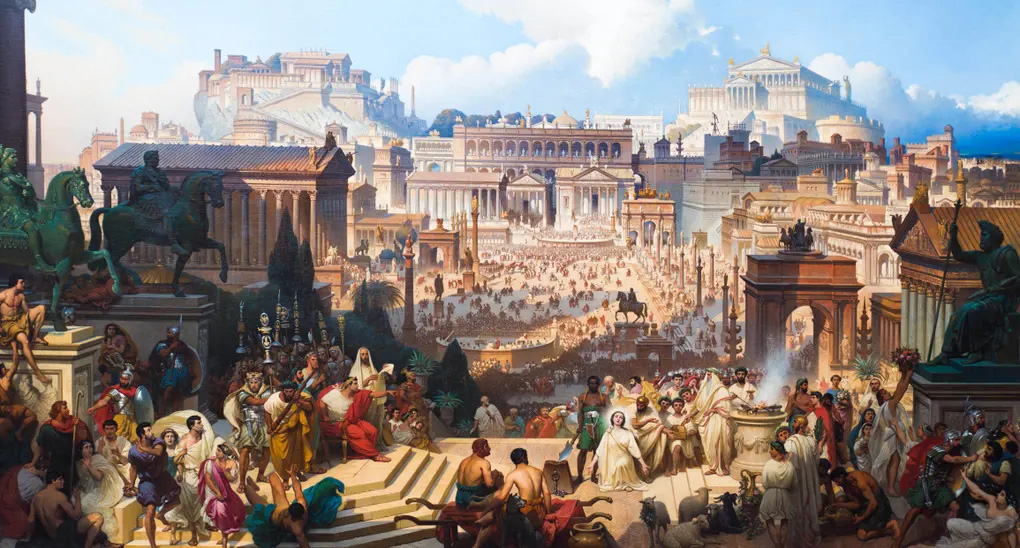The story of Ancient Rome is one of conquest, innovation, and collapse, spanning over a thousand years. From a small settlement on the banks of the Tiber River to the mighty Roman Empire, Rome dominated the Mediterranean world before succumbing to internal and external pressures.
I. The Rise of Rome (753 BCE – 27 BCE)

1. The Mythical Founding of Rome (753 BCE)
According to legend, Rome was founded in 753 BCE by Romulus and Remus, twin brothers raised by a she-wolf. Romulus eventually became the first king after killing his brother, giving the city its name.
2. The Roman Kingdom (753 BCE – 509 BCE)
Early Rome was ruled by kings, many of whom were Etruscan. During this period, Rome developed its religion, laws, and military traditions. The last king, Tarquinius Superbus, was overthrown, leading to the establishment of the Roman Republic.
II. The Roman Republic (509 BCE – 27 BCE)
1. Republican Government and Expansion
The Republic was governed by a Senate and elected officials called consuls. Over time, Rome expanded by conquering its neighbors, including the Etruscans, Samnites, and Greek colonies in Italy.
2. The Punic Wars (264 BCE – 146 BCE)
Rome fought Carthage, a powerful North African city-state, in a series of three wars:
-
First Punic War (264–241 BCE): Rome built a navy and defeated Carthage.
-
Second Punic War (218–201 BCE): General Hannibal famously crossed the Alps but was ultimately defeated by Scipio Africanus.
-
Third Punic War (149–146 BCE): Rome destroyed Carthage, making it a Roman province.
3. Julius Caesar and the End of the Republic
As Rome expanded, internal conflicts arose between the patricians (nobles) and plebeians (commoners). Ambitious generals, like Julius Caesar, took advantage of the chaos. Caesar became dictator for life in 44 BCE, but he was assassinated by senators fearing his power. His death led to a civil war, which ended when his adopted heir, Octavian (Augustus), defeated Mark Antony and Cleopatra in 31 BCE, marking the rise of the Roman Empire.
III. The Roman Empire (27 BCE – 476 CE)
1. The Pax Romana (27 BCE – 180 CE)
Under Augustus (27 BCE – 14 CE), Rome entered a period of peace and prosperity known as the Pax Romana (Roman Peace). The empire expanded to its greatest extent under Trajan (98–117 CE), covering parts of Europe, North Africa, and the Middle East.
2. Achievements of Rome
-
Engineering: Roads, aqueducts, and amphitheaters (e.g., the Colosseum).
-
Law: The Roman legal system influenced modern law.
-
Culture: Latin, Roman architecture, and philosophy spread across the empire.
3. The Crisis of the Third Century (235–284 CE)
Rome faced economic problems, corruption, and attacks from Germanic tribes and Persians. The empire nearly collapsed due to internal chaos and frequent changes in leadership.
4. The Division of the Empire (285 CE)
Emperor Diocletian (284–305 CE) split the empire into Western and Eastern halves to improve governance. Later, Constantine the Great (306–337 CE) reunited the empire and moved the capital to Byzantium (later Constantinople, now Istanbul).
IV. The Fall of the Western Roman Empire (476 CE)
1. Barbarian Invasions
Germanic tribes, pressured by the Huns, invaded Roman territory. Key events include:
-
410 CE – The Visigoths, led by Alaric, sacked Rome.
-
455 CE – The Vandals sacked Rome again.
-
476 CE – The last Western Roman Emperor, Romulus Augustulus, was deposed by the Germanic king Odoacer, marking the fall of the Western Roman Empire.
2. The Eastern Roman Empire (Byzantine Empire)
While the Western Empire fell, the Eastern Roman Empire (Byzantine Empire) survived until 1453 CE, when it fell to the Ottoman Turks.
V. The Legacy of Rome
-
Government & Law – Many modern legal systems are based on Roman law.
-
Architecture – Roman engineering influenced buildings worldwide.
-
Language – Latin evolved into Spanish, French, Italian, Portuguese, and Romanian.
-
Christianity – Rome played a crucial role in spreading Christianity, which became the empire’s official religion under Constantine.



